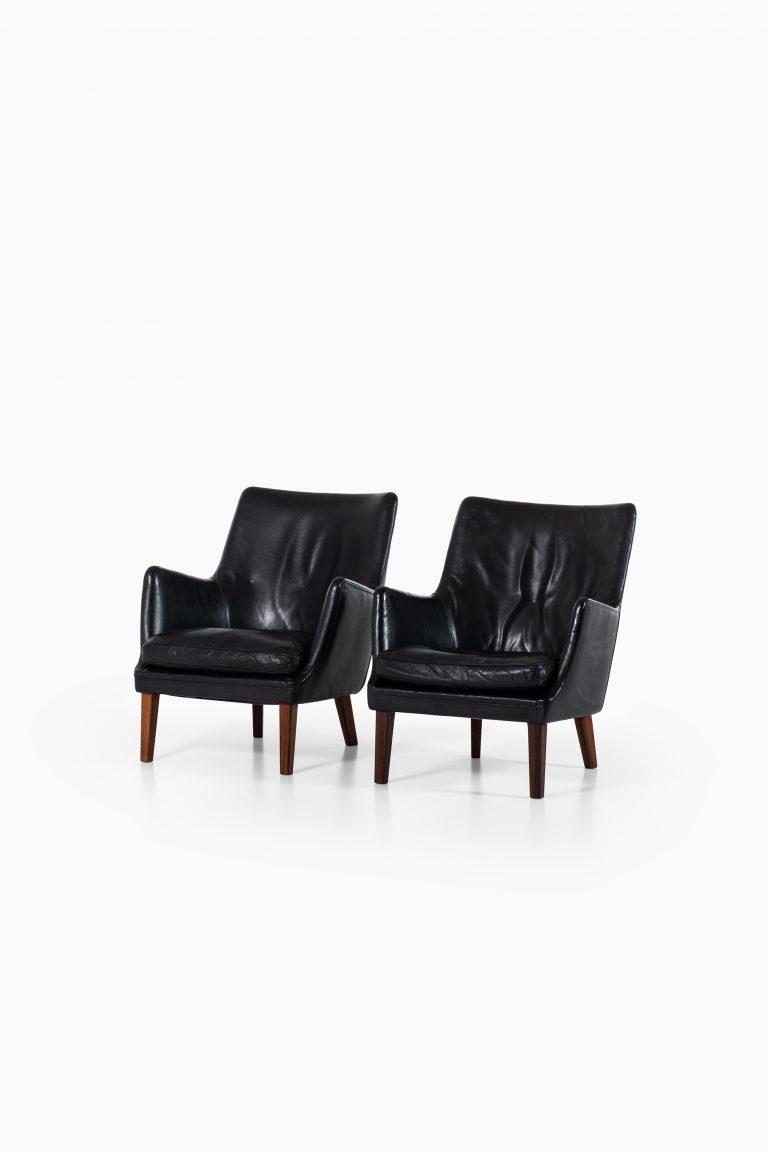Arne Vodder easy chairs
The BO-90 easy chairs, designed by Arne Vodder and produced by Bovirke in 1952, represent an early and exceptionally rare example of Vodder’s unique interpretation of Danish modernism. As one of Vodder’s more sculptural and organic creations, this pair encapsulates the designer’s signature approach—fusing refined craftsmanship with flowing lines and a sensitive use of materials.
These chairs are distinguished by their elegantly balanced frame, constructed from a nuanced combination of oak and teak. The use of two contrasting woods is both functional and aesthetic: oak provides structural strength and a light tonal foundation, while teak adds richness and visual depth to select details. The result is a frame that is at once robust and visually delicate, exhibiting the kind of subtle, thoughtful contrast for which Vodder is well known.
The chairs’ defining visual feature is the continuous curve that forms the armrests and backrest—a fluid gesture that not only enhances comfort but also lends the chairs a graceful, sculptural quality. This organic flow, subtly asymmetrical and soft-edged, is emblematic of Vodder’s early postwar experimentation with form. Unlike the strictly geometric lines of earlier modernist works, the BO-90 reflects a turn toward naturalism and human-centered design.
The rear legs are slightly splayed, and the front legs are modestly angled to lift the silhouette visually, giving the chairs a light, poised stance. The careful tapering and joinery throughout the frame attest to Bovirke’s high level of cabinetmaking skill. As a manufacturer, Bovirke was instrumental in introducing some of Vodder’s earliest designs to market, and their collaborative output stands as a cornerstone of mid-century Danish design.
The chairs have been sensitively reupholstered in a combination of grey and blue wool fabric—a palette that complements the warmth of the wooden frame while adding a contemporary refinement. The new upholstery follows the original contours of the design, preserving the integrity of Vodder’s proportions and accentuating the curvature of the backrest and seat.
Arne Vodder (1926–2009), a student of Finn Juhl, is regarded as one of Denmark’s most important designers of the mid-20th century. While his name is often associated with larger-scale furniture—such as desks, sideboards, and modular systems—his seating designs reveal a deeply personal and refined aesthetic sensibility. Vodder’s work was frequently characterized by a quiet sophistication: clean, organic lines, a love of expressive woods, and an architectural sense of proportion.
The condition of this pair is superb. The frames retain a well-preserved patina with minimal signs of wear, and the reupholstery is freshly executed with respect to the original design. Structurally, the chairs are sound, with all joints tight and finishes consistent.
Dimensions (cm) | W: 75.5 / D: 75 / H: 76 / Seat H: 39 |
| Producer | Bovirke |
| Color | Blue, Grey |
| Decade | 1950s |
| Country | Denmark |
| Style | Mid Century, Scandinavian Modern |
| Material | Fabric, Oak, Teak, Wool |
| Designed in | 1952 |
| Item Number | 201406 |
Arne Vodder
Arne Vodder was trained by Finn Juhl, who became his friend and business partner. Before concentrating on furniture alone, in 1951 he opened his own studio with the architect Anton Borg. Together they designed some 1,100 low-cost houses which prov...
Read more










